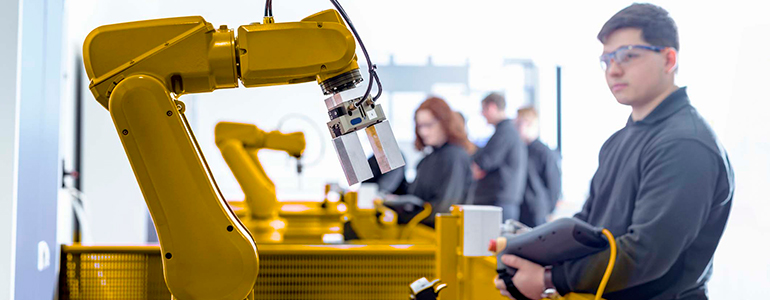Robots & Robotics Series - Part 2

01 Nov 2019
European Requirements
Robots and robotics are growing in popularity in multiple industries across the globe. In our previous post in this series, we explored potential hazards and testing options for robots to better ensure the performance and safety of these products. In addition to knowing these, it is also very important to know about regulatory requirements for different global markets. In this post, we'll explore the requirements in the European Union.
Robots in the EU are regulated based on their application. Industrial robots fall into the scope of the Machinery and EMC Directive. Manufacturers should follow existing EN and ISO standards on robotic devices; several are harmonized under the Machinery Directive.
- EN 12100: Safety of machinery - General principles for design - Risk assessment and risk reduction
- ISO 13849-1: Safety of machinery packaging
- EN ISO 10218-1: Robots and robotic devices - Safety requirements for industrial robots
- EN ISO 10218-2: Robots and robotic devices - Safety requirements for industrial robots; robot systems and integration
- EN ISO 13482: Robots and robotic devices - Safety requirements for personal care robots
- ISO/TS 15066: Robots and robotic devices - Collaborative robots
- EN 61000-6-2: Electromagnetic compatibility (EMC) Part 6-2: Generic standards - Immunity standard for industrial environments
- EN 61000-6-4: Electromagnetic compatibility (EMC) Part 6-4: Generic standards - Emission standard for industrial environments
In the EU, medical robots must adhere to IEC 60601-1 ED3+AMD1. This general standard must be applied in conjunction with new standards in development, such as:
- IEC 80601-2-77: Particular requirements for the basic safety and essential performance of robotically assisted surgical equipment
- IEC 80601-2-78: Particular requirements for the basic safety and essential performance of medical robots for rehabilitation, assessment, compensation or alleviation
For robots used in hazardous locations or potentially explosive environments, the ATEX Directive 2014/34/EU must be considered. If the safety of machinery is governed by safety distance, then EN 13857 applies. Other machinery standards may also be applicable.
Finally, some robots will need to comply with the Radio Equipment Directive (RED), which establishes safety and EMC requirements for equipment using the radio spectrum.
Stay tuned for insights on the requirements in the U.S. and Canada. And for more insights on quality and compliance for robots and robotics, download our complimentary fact sheet.

Ang Zhu,
Engineer
Ang Zhu is an engineering lead at Intertek's Cortland New York facility, where he is responsible for certifying power generation and conversion equipment, functional safety consultation, researching new standards and technologies, and providing regional and global technical support and guidance. He is a committee member of IEC 61508 TC 65 and E.I.T in New York State. He received a bachelor's degree from South China University of Technology (SCUT)and master's degree in Electrical Engineering from both SCUT and New York University Tandon School of Engineering